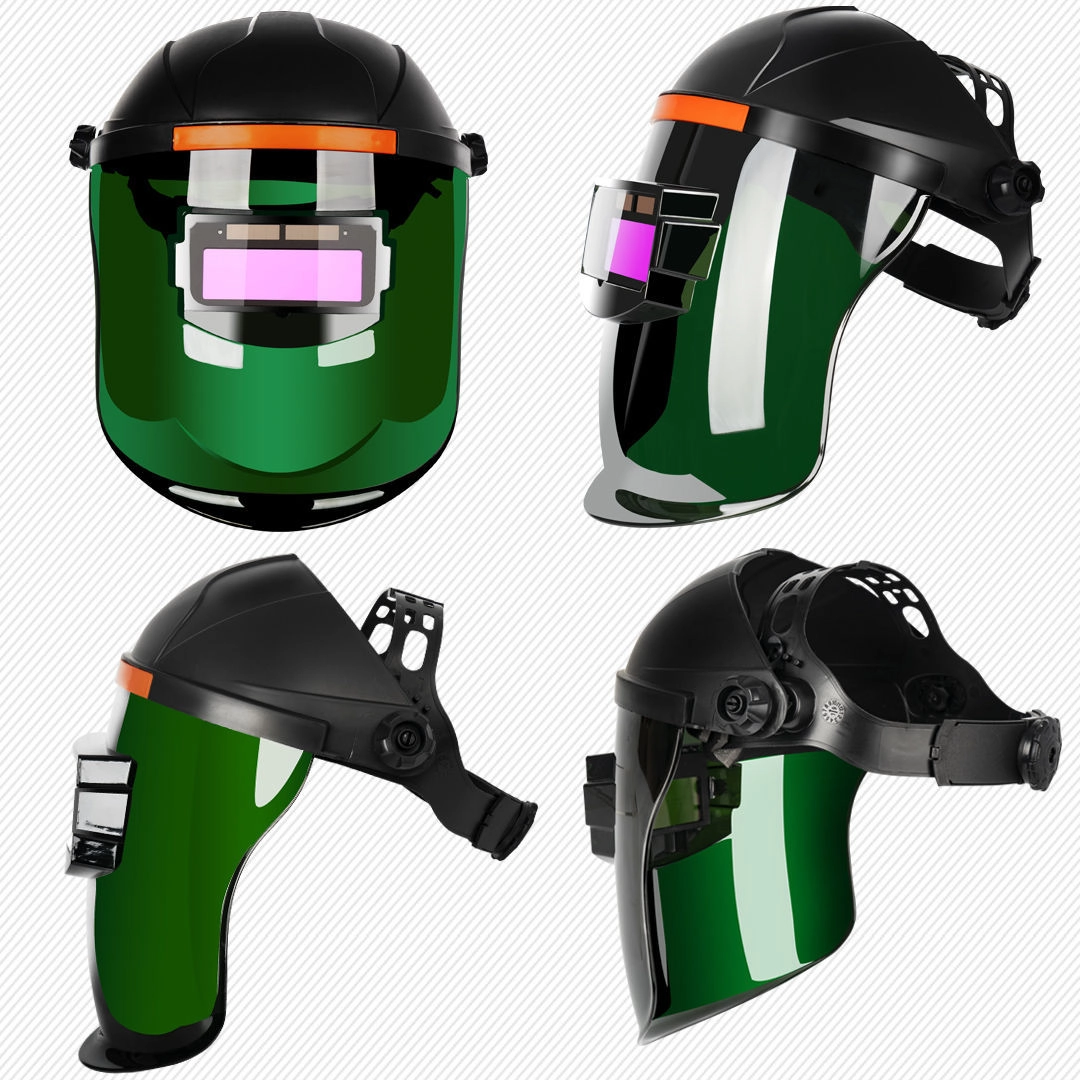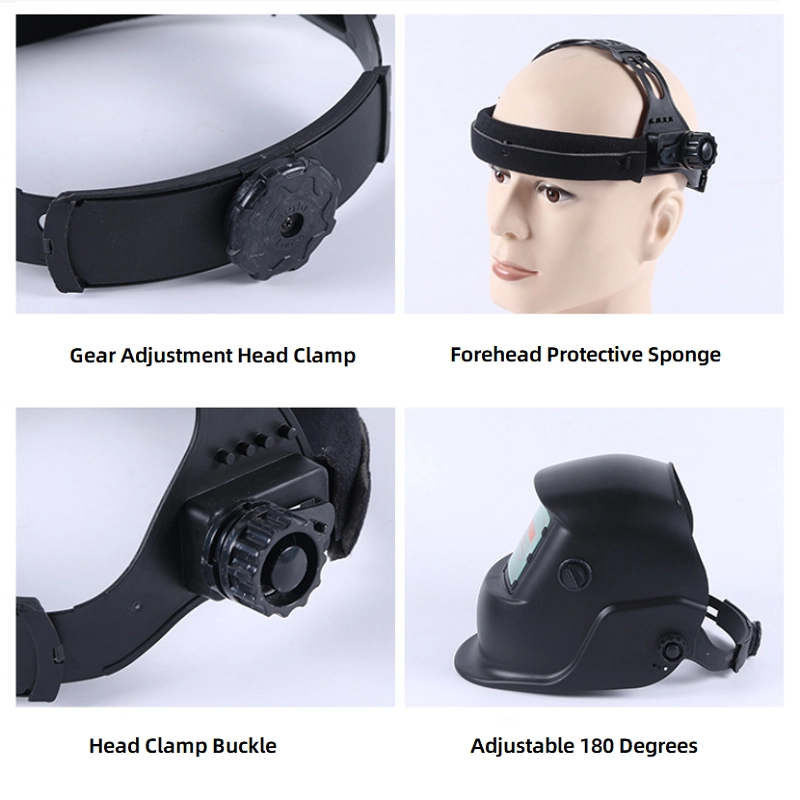Choosing the Best Welding Helmet for Optimal Safety and Vision
Welding is a fantastic skill, but it's crucial to protect yourself from the intense light and heat of the welding arc. This article will guide you through everything you need to know to choose the best welding helmet for your needs, ensuring safety and comfort, whether you're just starting out or are a seasoned professional welder. We'll explore different types of welding helmets and features to look for, so you can weld with confidence and protect your eyes for the long-term. Let's dive in and find the right welding helmet for you!
1. Why is a Welding Helmet Absolutely Essential for Every Welder?
Welding is a powerful process that joins metals together, but it also produces intense light and heat that can be very dangerous to your eyes and skin. That's where a welding helmet becomes absolutely essential. Think of it as your personal shield against the hazards of welding. Without a proper welding helmet, you're putting yourself at serious risk of eye damage, burns, and discomfort.
The intense welding arc emits ultraviolet (UV) and infrared (IR) radiation, which are invisible rays that can severely damage your eyes. Looking directly at a welding arc without protection is like staring at the sun – but much, much worse. It can cause a painful condition called "arc eye" or "welder's flash," which feels like having sand in your eyes and can lead to temporary blindness. Over time, repeated exposure without protection can lead to more serious, long-term eye health problems. A welding helmet is designed to filter out these harmful rays, protect your eyes and face from the welding light, and prevent these injuries. It's not just about seeing the weld; it's about safety and comfort so you can focus on doing your welding work effectively and safely. Every welding job, big or small, requires a welding helmet.

Variable Photoelectric Welding Protective Mask
2. What are the Different Types of Welding Helmets Available for Various Welding Processes?
When it comes to welding, not all helmets are created equal! There are different types of welding helmets designed to suit various welding processes and welder preferences. Understanding these types of helmets will help you choose a welding helmet that's right for you. The two main categories you'll encounter are passive and auto-darkening welding helmets.
Passive helmets are the traditional, simpler type. They have a fixed shade lens, usually shade 10, which is dark enough for most welding applications. You have to manually nod your head to lower the helmet before striking an arc and lift it up to see after welding stops. These are more basic but can be reliable for welders who are used to them. On the other hand, auto-darkening helmets are a more modern invention. They use electronic sensors to detect the welding arc and automatically darken the lens within milliseconds. This means you can keep your helmet down the whole time, improving safety and efficiency, especially for long welding sessions. Within auto-darkening welding helmet types, you'll find variations in viewing area size, shade adjustability, and features like grind mode. Whether you are doing mig welding, tig welding, or stick welding, there's a type of welding helmet designed to enhance your welding experience.
3. Auto-Darkening Welding Helmets: How Do They Enhance Safety and Efficiency in Welding Operations?
Auto-darkening welding helmets have revolutionized welding operations by significantly improving both safety and efficiency. The key feature of an auto-darkening helmet is its ability to automatically switch from a light state to a dark state the moment a welding arc starts. This happens incredibly fast, typically within milliseconds, thanks to electronic sensors that detect the welding light.
Imagine you're getting ready to weld. With a passive helmet, you'd have to position your work, lift your helmet, strike your arc, and then quickly nod your helmet down. This "helmet nod" can be cumbersome and can even lead to neck strain over time, especially during long hours of welding work. But with an auto-darkening helmet, you simply put on the helmet, position your work, and start welding. The lens darkens instantly when the arc ignites, allowing you to see clearly before, during, and after the weld without any manual adjustments. This not only increases safety by keeping your face and eyes protected at all times but also boosts efficiency by eliminating the need for the helmet nod. Welders can work faster and more precisely, especially on complex welding projects. Many auto-darkening welding helmets offer adjustable shade settings, allowing you to match different welding processes and intensities. Some even have a grind mode, letting you switch between welding and grinding without removing the helmet. For professional welding and even hobbyist welding applications, auto-darkening welding helmets are a game-changer.

Automatic Dimming Face Protection Head Mounted Welding Mask
4. Passive vs. Auto-Darkening Helmets: Which Type of Welding Helmet Best Suits Your Welding Needs?
Choosing between passive and auto-darkening helmets depends largely on your welding needs, budget, and personal preferences. Both types of welding helmet offer protection, but they do so in different ways. Passive helmets are generally more affordable and simpler in design. They rely on a fixed dark shade lens to protect your eyes from the welding arc.
If you are on a tight budget or only weld occasionally, a passive helmet might be sufficient. They are reliable and require no batteries or electronics, which can be appealing to some welders. However, the fixed shade means you can't see clearly before or after welding without lifting the helmet, which can be less convenient and potentially less safe in busy welding environments. Auto-darkening helmets, while typically more expensive upfront, offer significant advantages in terms of safety, comfort, and efficiency. The auto-darkening feature allows you to see clearly at all times, improving precision and reducing eye strain. For welders who weld frequently, for long hours, or in professional settings, the benefits of an auto-darkening welding helmet often outweigh the higher cost. They are particularly beneficial for tig welding and mig welding, where arc starts and stops are frequent. Ultimately, the best welding helmet is the one that provides adequate protection, fits comfortably, and meets the demands of your specific welding tasks. Consider how often and what kind of welding work you do when making your decision.
5. What Key Features Should You Look For When Choosing a Welding Helmet for Safety and Comfort?
When selecting a welding helmet, focusing on key features ensures you get the right welding helmet for safety and comfort. Beyond just protection, a good helmet should enhance your welding experience. One crucial feature is the safety standard rating. Make sure the helmet meets safety standards like ANSI Z87.1 or CE EN175. This certification indicates the helmet has been tested to withstand impact and provide adequate UV and IR protection.
Another important feature is the viewing area. A larger viewing area allows for a wider field of vision, improving your ability to see the workpiece and your surroundings. This is especially helpful for complex welds or when working in tight spaces. Shade adjustment is also key, particularly in auto-darkening helmets. Being able to adjust the shade level allows you to match different welding processes and amperage levels. Look for helmets with a wide shade range (e.g., DIN 9-13). Comfort is paramount, especially for long welding sessions. Look for a helmet with helmet with adjustable headgear that distributes weight evenly and provides a snug, comfortable fit. Features like padded headbands and lightweight shells can significantly reduce fatigue during long welding sessions. Consider also the response time of auto-darkening welding lenses. Faster response times mean better eye protection, especially during arc welding. Finally, features like grind mode, sensitivity and delay controls, and replaceable lenses can add to the overall value and usability of the welding helmet for your needs.
6. How Does the Viewing Area of a Welding Helmet Impact Your Welding Experience?
The viewing area of a welding helmet significantly impacts your welding experience, affecting visibility, awareness, and overall comfort. A larger viewing area offers a wider field of vision, which is crucial for seeing the entire weld puddle, the surrounding workpiece, and your work environment without excessive head movements.
With a welding helmet that has a larger viewing area, you can better maintain your orientation and balance, especially when welding in awkward positions. It also enhances safety by increasing your peripheral vision, allowing you to be more aware of potential hazards around you in the welding environment. For intricate welding operations or when fitting up parts, a wider view makes it easier to see details and ensure accuracy. Conversely, a smaller viewing area can feel restrictive and claustrophobic. It may require you to move your head more frequently to see different parts of the weld joint, which can slow down your welding work and increase strain during long welding sessions. While helmets with smaller viewing areas may be lighter and sometimes more affordable, the trade-off in visibility can be significant, especially for professional welding tasks that demand precision and efficiency. When you look for in a welding helmet, consider the type of welding applications you typically handle. For general purpose welding, a standard viewing area might suffice, but for detailed or out-of-position welding, investing in a new helmet with a larger viewing area can greatly improve your productivity and reduce eye and neck strain.
7. Considering Welding Environment: How to Choose a Helmet that Best Fits Your Working Conditions?
The welding environment plays a crucial role in choosing the right welding helmet. Different working conditions demand different helmet features to ensure both safety and performance. If you primarily weld outdoors, especially in sunny conditions, consider a helmet with excellent UV and IR protection and perhaps a silver or reflective shell to reduce heat buildup inside the helmet.
For indoor welding environments, especially those that are poorly lit, a helmet with a light state shade (the shade level when not welding) that is bright and clear is beneficial. This helps you see your setup clearly before striking an arc. If you work in confined spaces, a compact and lightweight helmet is essential to reduce bulk and allow for easier movement. Also, consider the ventilation in your welding environment. Some helmets come with built-in ventilation systems or are designed to be compatible with respirators, which is crucial if you're welding in areas with poor air quality or where fumes are a concern. For heavy industrial welding operations, durability is key. Look for helmets made from robust materials that can withstand harsh conditions and frequent use. If you frequently switch between welding and grinding, a helmet with a dedicated grind mode is highly convenient. Think about the ambient welding light in your workspace too. In brightly lit workshops, helmets with good light sensors will prevent nuisance auto-darkening from non-arc light sources. By carefully considering your typical welding environment, you can choose a helmet that not only protects you but also enhances your efficiency and comfort in those specific conditions.
8. Ensuring Proper Fit and Comfort: Why is Adjustable Headgear Important in a Welding Helmet?
Proper fit and comfort are paramount when it comes to welding helmets, and adjustable headgear is the key to achieving both. An ill-fitting helmet can be uncomfortable, distracting, and even unsafe, especially during extended welding sessions. Helmet with adjustable headgear allows you to customize the fit to your head size and shape, ensuring the helmet sits securely and comfortably.
Adjustable headgear typically includes features like adjustable straps for circumference, crown height, and even forward and backward tilt. This adjustability is crucial for distributing the weight of the welding helmet evenly across your head, reducing pressure points and fatigue during long welding sessions. A well-adjusted helmet stays in place without slipping or moving around, even when you nod or move your head, which is essential for maintaining consistent protection and visibility. Comfortable headgear often includes padding on the forehead band and around the head, further enhancing comfort and cushioning. For welders who wear glasses or other personal protective equipment (PPE) under their helmets, adjustability is even more important to accommodate these items without compromising fit or comfort. When you put on the helmet, it should feel secure but not too tight, and it should not cause pressure or discomfort after hours of welding. Investing in a welding helmet with high-quality, highly adjustable headgear is an investment in your safety and comfort, directly impacting your productivity and overall welding experience, especially for professional welding engineers and those engaged in extended welding.
9. Maintaining Your Welding Helmet: How to Ensure Longevity and Consistent Protection?
Proper maintenance of your welding helmet is essential to ensure its longevity and consistent protection. A well-maintained helmet will not only last longer but also continue to provide the safety standard of protection you rely on for every welding task. Regular cleaning is the first step. Wipe down the helmet shell and lenses regularly with a soft cloth or lens wipes to remove dust, dirt, and spatter. Avoid using harsh chemicals or abrasive cleaners, as these can damage the helmet materials or lens coatings.
Inspect the lenses regularly for scratches, cracks, or damage. Replace the lenses, both outer and inner cover lenses, as soon as they become scratched or damaged, as these can compromise visibility and protection. For auto-darkening helmets, check the batteries regularly and replace them as needed to ensure the auto-darkening function works reliably. Store your welding helmet in a clean, dry place when not in use, ideally in a helmet bag or case, to protect it from dust, moisture, and physical damage. Inspect the headgear periodically for wear and tear. Replace worn-out straps or padding to maintain a secure and comfortable fit. If your helmet has replaceable sweatbands, change them regularly for hygiene and comfort, especially in hot and humid welding environments. By following these simple maintenance steps, you can significantly extend the lifespan of your welding helmet and ensure it continues to provide reliable eyes and face protection throughout its use. This is a small effort that contributes greatly to your long-term eye health and safety in welding work.
10. Investing in the Best Welding Helmet: What are the Long-Term Benefits for Your Health and Welding Quality?
Investing in the best welding helmet might seem like a significant expense initially, but the long-term benefits for your health and welding quality are invaluable. A high-quality helmet is not just a piece of safety gear; it's an investment in your well-being and professional success as a welder. One of the most critical long-term benefits is the protection of your vision. A best welding helmet provides superior eyes and face protection against harmful UV and IR radiation, minimizing the risk of long-term eye health issues like cataracts and macular degeneration.
Comfort is another significant long-term benefit. A comfortable, lightweight helmet with helmet with adjustable headgear reduces strain and fatigue during long welding sessions, allowing you to work more efficiently and with greater focus. This, in turn, improves your welding quality. Better visibility through high-quality auto-darkening welding lenses with a larger viewing area allows for more precise welds, fewer errors, and less rework. Features like grind mode and adjustable shades streamline your workflow, saving time and increasing productivity. A durable welding helmet can last for many years if properly maintained, making it a cost-effective investment over time. Moreover, using a proper welding helmet that meets or exceeds safety standards reduces the risk of workplace accidents and injuries, which can have significant financial and personal implications. In essence, choosing the right welding helmet is about prioritizing your safety and comfort, which directly translates to better welding experience, improved welding quality, and safeguarding your long-term eye health. It's about getting a welding helmet for long-term health.
Key Takeaways: Choosing Your Perfect Welding Helmet
- Safety First: Always prioritize a welding helmet that meets or exceeds relevant safety standards to protect your eyes and face from harmful radiation and impact.
- Type Matters: Understand the difference between passive and auto-darkening helmets and choose the type of welding helmet that best suits your welding needs and budget. Auto-darkening offers enhanced safety and efficiency, especially for frequent welders.
- Features to Consider: Look for key features like viewing area size, shade adjustability, response time (for auto-darkening), and grind mode to optimize your welding experience.
- Comfort is Crucial: Ensure the welding helmet has adjustable headgear and a comfortable fit to reduce fatigue and improve focus, particularly during extended welding.
- Maintenance Matters: Regularly clean and inspect your welding helmet to ensure its longevity and consistent protection. Replace lenses and batteries as needed.
- Invest Wisely: Investing in a best welding helmet is an investment in your long-term eye health, safety, and welding quality. Choose a helmet that provides the best of both worlds: protection and performance.
Check out our wide range of high-quality welding helmets, including our Variable Photoelectric Welding Protective Mask for advanced auto-darkening features. For those needing robust protection for heavy-duty tasks, consider our Automatic Dimming Face Protection Head Mounted Welding Mask. Don't forget to pair your helmet with our durable Heat and Flame Resistant Cowhide Welding Work Apron for complete protection. And for those smaller jobs, you might find our 10.5'' Cowhide Leather Short Working Gloves to be the perfect companion. For comprehensive head protection, consider our Dongtie Flame Retardant Cotton Welding Cap.






